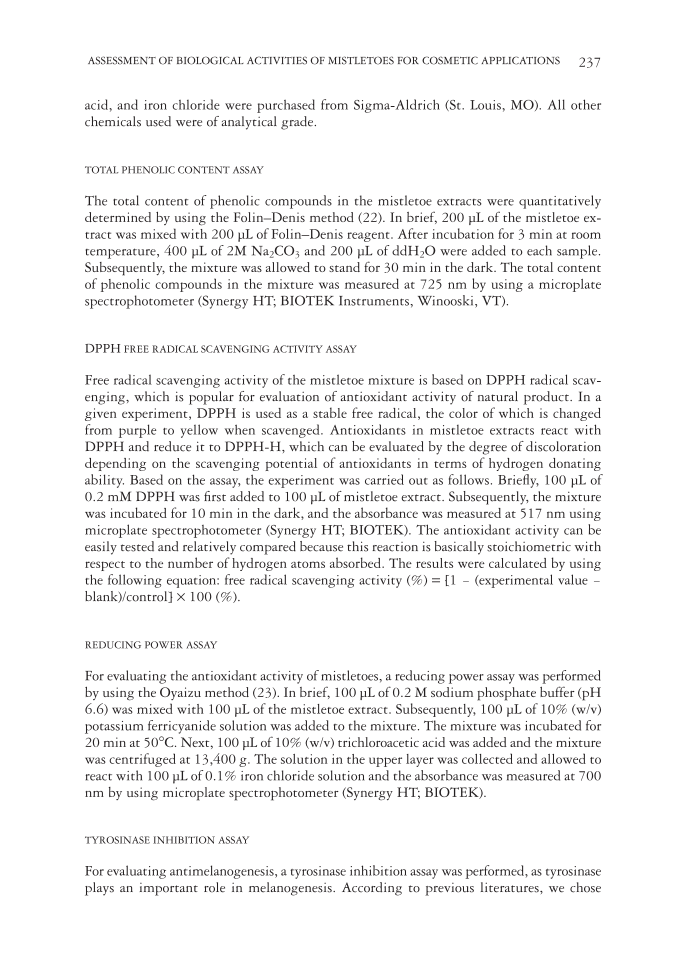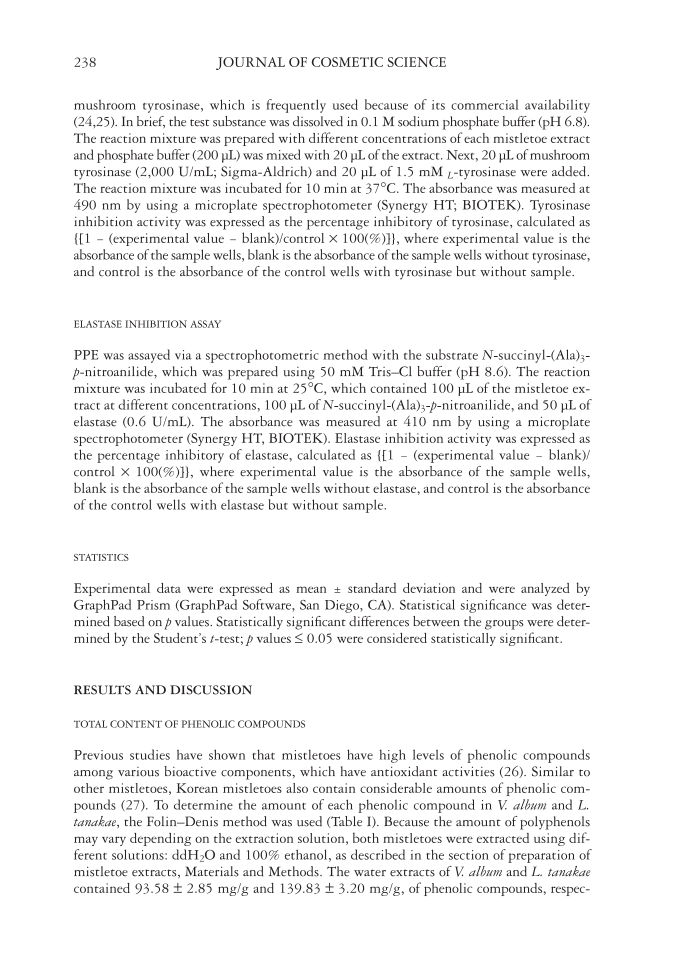ASSESSMENT OF BIOLOGICAL ACTIVITIES OF MISTLETOES FOR COSMETIC APPLICATIONS 237 acid, and iron chloride were purchased from Sigma-Aldrich (St. Louis, MO). All other chemicals used were of analytical grade. TOTAL PHENOLIC CONTENT ASSAY The total content of phenolic compounds in the mistletoe extracts were quantitatively determined by using the Folin–Denis method (22). In brief, 200 μL of the mistletoe ex- tract was mixed with 200 μL of Folin–Denis reagent. After incubation for 3 min at room temperature, 400 μL of 2M Na2CO3 and 200 μL of ddH2O were added to each sample. Subsequently, the mixture was allowed to stand for 30 min in the dark. The total content of phenolic compounds in the mixture was measured at 725 nm by using a microplate spectrophotometer (Synergy HT BIOTEK Instruments, Winooski, VT). DPPH FREE RADICAL SCAVENGING ACTIVITY ASSAY Free radical scavenging activity of the mistletoe mixture is based on DPPH radical scav- enging, which is popular for evaluation of antioxidant activity of natural product. In a given experiment, DPPH is used as a stable free radical, the color of which is changed from purple to yellow when scavenged. Antioxidants in mistletoe extracts react with DPPH and reduce it to DPPH-H, which can be evaluated by the degree of discoloration depending on the scavenging potential of antioxidants in terms of hydrogen donating ability. Based on the assay, the experiment was carried out as follows. Briefl y, 100 μL of 0.2 mM DPPH was fi rst added to 100 μL of mistletoe extract. Subsequently, the mixture was incubated for 10 min in the dark, and the absorbance was measured at 517 nm using microplate spectrophotometer (Synergy HT BIOTEK). The antioxidant activity can be easily tested and relatively compared because this reaction is basically stoichiometric with respect to the number of hydrogen atoms absorbed. The results were calculated by using the following equation: free radical scavenging activity (%) = [1 - (experimental value - blank)/control] × 100 (%). REDUCING POWER ASSAY For evalu ating the antioxidant activity of mistletoes, a reducing power assay was performed by using the Oyaizu method (23). In brief, 100 μL of 0.2 M sodium phosphate buffer (pH 6.6) was mixed with 100 μL of the mistletoe extract. Subsequently, 100 μL of 10% (w/v) potassium ferricyanide solution was added to the mixture. The mixture was incubated for 20 min at 50°C. Next, 100 μL of 10% (w/v) trichloroacetic acid was added and the mixture was centrifuged at 13,400 g. The solution in the upper layer was collected and allowed to react with 100 μL of 0.1% iron chloride solution and the absorbance was measured at 700 nm by using microplate spectrophotometer (Synergy HT BIOTEK). TYROSINASE INHI BITION ASSAY For evaluating antimelanogenesis, a tyrosinase inhibition assay was performed, as tyrosinase plays an important role in melanogenesis. According to previous literatures, we chose
JOURNAL OF COSMETIC SCIENCE 238 mushroom tyrosinase, which is frequently used because of its commercial availability (24,25). In brief, the test substance was dissolved in 0.1 M sodium phosphate buffer (pH 6.8). The reaction mixture was prepared with different concentrations of each mistletoe extract and phosphate buffer (200 μL) was mixed with 20 μL of the extract. Next, 20 μL of mushroom tyrosinase (2,000 U/mL Sigma-Aldrich) and 20 μL of 1.5 mM L -tyrosinase were added. The reaction mixture was incubated for 10 min at 37°C. The absorbance was measured at 490 nm by using a microplate spectrophotometer (Synergy HT BIOTEK). Tyrosinase inhibition activity was expressed as the percentage inhibitory of tyrosinase, calculated as {[1 - (experimental value - blank)/control × 100(%)]}, where experimental value is the absorbance of the sample wells, blank is the absorbance of the sample wells without tyrosinase, and control is the absorbance of the control wells with tyrosinase but without sample. ELASTASE INHIBITION ASSAY PPE was assayed via a spec trophotometric method with the substrate N-succinyl-(Ala)3- p-nitroanilide, which was prepared using 50 mM Tris–Cl buffer (pH 8.6). The reaction mixture was incubated for 10 min at 25°C, which contained 100 μL of the mistletoe ex- tract at different concentrations, 100 μL of N-succinyl-(Ala)3-p-nitroanilide, and 50 μL of elastase (0.6 U/mL). The absorbance was measured at 410 nm by using a microplate spectrophotometer (Synergy HT, BIOTEK). Elastase inhibition activity was expressed as the percentage inhibitory of elastase, calculated as {[1 - (experimental value - blank)/ control × 100(%)]}, where experimental value is the absorbance of the sample wells, blank is the absorbance of the sample wells without elastase, and control is the absorbance of the control wells with elastase but without sample. STATISTICS Experimental data were expressed as mean ± standard deviation and were analyzed by GraphPad Prism (GraphPad Software, San Diego, CA). Statistical signifi cance was deter- mined based on p values. Statistically signifi cant differences between the groups were deter- mined by the Student’s t-test p values 0.05 were considered statistically signifi cant. RESULTS AND DISCUSSION TOTAL CONTENT OF PHENOLIC COMPOUNDS P revious studies have shown that mist letoes have high levels of phenolic compounds among various bioactive components, which have antioxidant activities (26). Similar to other mistletoes, Korean mistletoes also contain considerable amounts of phenolic com- pounds (27). To determine the amount of each phenolic compound in V. album and L. tanakae, the Folin–Denis method was used (Table I). Because the amount of polyphenols may vary depending on the extraction solution, both mistletoes were extracted using dif- ferent solutions: ddH2O and 100% ethanol, as described in the section of preparation of mistletoe extracts, Materials and Methods. The water extracts of V. album and L. tanakae contained 93.58 ± 2.85 mg/g and 139.83 ± 3.20 mg/g, of phenolic compounds, respec-
Purchased for the exclusive use of nofirst nolast (unknown) From: SCC Media Library & Resource Center (library.scconline.org)


















































